ctnchpr's Asclepias variegata Seed recipients
May I ask a favor?
Would those of you who were fortunate to receive Red Ring Milkweed seeds from ctnchpr via Jeff recently, please come back and tell us how you fared with getting them to germinate, as well as the germination methods you tried?
If one is able to locate seed of this milkweed, it appears to be quite difficult to get them to germinate. I would love to hear what method everyone tried with their seeds to use as a reference for future attempts at germination.
My thanks for your time.
Mary
Comments (85)
Mystic_Charlie
11 years agoHello Mary. I wanted to relay my experience to you for a very specific reason. You see, 2 years ago I obtained some seeds of A. variegata from a friend in Groton, CT who had obtained them from you. I think she gave me about a dozen seeds. Two years ago, I planted 6 of them, 2 seeds each in 2 gallon pots. Out of the 3 pots, 4 seedlings emerged. And then the slugs found them and devoured all completely but 1. This survived the summer largely gnawed on, barely, but never emerged from the soil this past spring, 2012. I germinated the remaining 6 seeds in 2 pots of 3 seeds each in 2012. I had all 3 germinate in one pot and 2 in the other, plus, I used slug bait to deter the voracious slugs in my yard. (I didn't want to do it, but considering the ridiculous level of damage they do to all of my native seedlings, I had to do something drastic). Amazingly, most of the little seedlings were subsequently devoured by Monarch caterpillars. They really seem to love the seedlings. You see, I had a large flat of Asclepias incarnata nearby, about 100 seedlings. The monarch butterflies found this and promptly about two dozen caterpillars appeared and I didn't have the heart to pot-out the incarnata. The caterpillars roamed about, eating all but a couple dozen incarnata seedlings as well as devouring most of the variegata seedlings. Very quickly, I might add. BTW: The bait didn't seem to bother the caterpillars at all. Apparently the seedlings don't take the poison up or they simply didn't ingest enough to bother them. I have been keeping the pot with the surviving seedling in an unheated attached garage to protect the young seedling, rarely going below freezing, but often close to that, but I do hope to find a suitable microclimate for it in my small yard. I stratified all of these seeds for a minimum of 90 days, and I consider that I got a reasonable rate of germination. Well, I only have the one seedling after 2 years, and it remains to be seen whether it germinates the second spring. I will try to keep you posted. Charlie.
Iris GW
11 years agoHere is an interesting bit about how milkweeds get pollinated. Sounds tricky.
Here is a link that might be useful: Milkweed pollinatin.
Related Discussions
Asclepias variegata - 2010
Q
Comments (18)Hi ctnchpr, Just curious if your plants set any seed pods this year and if so will any be available? I got a few of last years seed through Jeff but no germination. I was dissappointed as I had seed from others that all(3 each) germinated. I would really like to get some seed pods from your plants as they seem to grow so well. Thanks, Mark (wildflowerman_2000)...See MoreQuestion for ctnchpr on Asclepias Variegata
Q
Comments (0)hi. I was wondering if you has seeds of Asclepias Variegata for SASE, trade, or if you could send me some. E-mail me please. Click on my name above (blue) and click send me an e-mail. Thanks, Danny...See Morecold stratification of milkweed seeds
Q
Comments (6)I always wintersow my milkweed seeds. That way, I know my success rate and can choose my planting sites accordingly. This year I plan to increase my milkweed plantings by at least a magnitude of ten. I hope to have plenty of spare plants to donate/gift to anyone with a patch of dirt to spare. I'm also growing extra native pollen-producing plants for my yard and others. Check out the wintersowing forum, if you haven't already. Results are nearly foolproof. Martha...See MoreRedring Milkweed Seed Availibility for 2014
Q
Comments (20)Hi Dana, Yes, powdery mildew on these seedlings seems to be a problem as some of my seedlings have it too. I moved the seedlings to an area where they have better air flow and it seems to have helped. I would guess the tallest of my seedlings might be 5-6 inches tall and others still in 3 inch pots are about 3-4 inches tall and all are ready to be planted out, I think. I don't plan to try and overwinter in pots. In my limited experience with a few older 'young' plants, they are slow to grow. I'm hoping it is because they are working on developing a good root structure in place of top growth. I had one older 'young' plant bloom this year but it only produced one flower head on one stalk. Not sure if it is something I'm not doing right or if this is their normal growth pattern. Thank you for taking the time to reply and to update us on your progress. Best of luck with your seedling. Mary...See MoreMark (wildflowerman_2000) Rose
11 years agoHi Folks,
Been quite a while since I've chimed in here. Yesterday I was checking my seed containers and low and behold the seeds from 3 years ago are germinating. I have 6 of them popping up. I was floored to say the least. Any way I have been trying some new methods which seem to work much better for me.In the past I have been giving the seed a moist cold treatment either in the fridge or
outside(winter sowing). By accident last year I placed several packets of seed in the fridge without any added moisture. I also left several packets (from the same group) outside exposed to the winter temps. I decided to just go ahead and sow them last spring in March and they germinated within 3 weeks. I think every single one of them! So this year I did the same thing and sowed them in early February and they germinated even quicker. The ones from last year that I gave moisture to only had a few seedlings to germinate. I'm now wondering if the moisture may be killing the embryos. I also did the same thing this year with the following species A. viridiflora, verticillata, purpurascens, exalta, asperula and incarnata with the same results although all these species took a little longer to start germinating.
Just thought you all might be interested in my discovery.
Markbutterflymomok
11 years agoWildflowerman,
I found your post quite interesting as I read another place this spring about moisture preventing germination of asclepias seeds. I think the information came from Native Plants in Texas. Monarch Watch is making a big effort to grow and make available a lot of different species throughout the US. I noticed that variegata is on their list, but not for my state. So, there is a push to get Asclepias planted throughout the Monarch migration flyway.
I have variegata seeds in moist sand in the fridge. I'm hoping these seeds germinate this spring. I also read that the seeds should not be handled but you should wear gloves. And conditions should be kept absolutely sterile. I have stratified a number of species this spring using the damp sand method. However, some species did not germinate at all. I wondered about the source. But, it may be my methods. So, in the future I will try some new ways, including your way of just using cold.
Hope to see someone posting that they get seed pods this summer. I have two variegata plants that have survived the gophers (they ate at least 6 plants). These should flower, and I will do some hand pollination. I hand pollinated a Purple MW two years ago and got an abundance of seed pods. I left the flowers alone last year and had no pods at all. I totally agree that asclepias is a challenging species to grow. Only the Phycocarpus and the curassavica grow easily for me, and these aren't natives and are annuals in my area. I currently have seedlings of pumila, ovafolia, common, Davis, speciosa, viridis, Sullivan's and others. My first batch of Purple did not germinate; but the seeds did not look good (bought them from the same online source as the other seeds that didn't germinate). The last seeds came from Prairie Moon Nursery. I always get good seed germination from their seeds. So, hopefully, I will get some new Purple plants. Purpurascens and variegata are my absolute favorites.
Good luck to all of you who are trying to get this plant growing and seeding. And, thanks for sharing your experiences which help all of us in our endeavors.
Sandy
Mary Leek
Original Author10 years agoMark, it's so nice to see you posting. I must visit this forum more often.
Sandy, what do you use to hand pollinate your milkweed? I'm going to try that each day until my A variegata blooms are gone. Maybe I'll get lucky and get a seed pod, either by this method or by natural occurance. I've looked up photos of the seed pod and it matures at a very large size, in comparison to the plant. Judging by the size, even one seed pod should provide quite a few seeds.
Mary
Mark (wildflowerman_2000) Rose
10 years agoHi Lady,
Hope you have been doing well. I had a little success last year using tweezers and following the direction on the website. I would recommend you print it out and also watch the video several times as it really covers the process pretty well. I did get 6 pods to form out of about 25 plants I worked with. Not good percentages but better than nothing. I was actually out this past Saturday doing it again and have a few more to try as they open over the next few weeks. I'm attaching a couple of photos from the plants I pollinated this past weekend for your enjoyment and here is the link to the website:
http://butterflygardening.wordpress.com/2011/04/23/milkweed-pollination/Germination this winter/spring has been pretty good also. I have plants that are already 6-7" tall that germinated in February and in the same seed flats I've just had another flush of seedlings to germinate. A little strange but glad to have them at least germinating. I actually planted out 18 of the biggest seedlings last week in the garden to see how they will do.
Keep in touch.
MarkMark (wildflowerman_2000) Rose
10 years agoAnd a little side note and teaser-Asclepias quadrifolia is becoming one of my new favorites. It's like a miniature variegata with the extra bonus of incredible fragrance. They open here in NC yesterday.
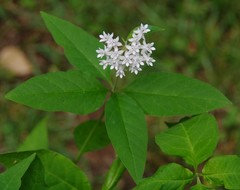
Mary Leek
Original Author10 years agoHi Mark,
Great photo's of lovely plants! They all look so healthy; you are an excellent steward of the land. And thank you for sharing the photo of the Asclepias quadrifolia. I have read that name this year somewhere and didn't know a thing about it. It looks like a dainty woodland wildflower, which, come to think of it, is exactly what it is! :-)
Thanks, also, for the heads up on the steps to take to pollinate the milkweed. Six seed pods is fantastic! I tried using the tiny watercolor brush again today and I believe I was pulling out the pollinium, but not certain I ever got it to hang on a new flower. I'll have to get out tomorrow and buy some needle nosed tweezers and give that a try. My eyes aren't good so not certain I can handle such a delicate procedure but willing to try. I would like to watch one A variegata seed pod develop during my lifetime, just for the experience.
Thanks once again for the encouragement and for sharing photo's of your beautiful milkweed. Twenty five A variegata plants is amazing (and with little seedlings still to plant)!
Mary
butterflymomok
10 years agoI just checked this site today after being gone for a while. Mary, I used the method that was shown on Youtube to pollinate the milkweeds. I had good success with Purple MW, but did not have success with the variegata. Two of my small variegata plants did emerge--these were purchased from Mary Ann at Pine Ridge Nursery in 2011 . I put them in pots last fall that I left out and sunk in the garden. This spring, I made the hardware cloth baskets and planted them. They are very tiny still as the gophers had devoured quite a bit of the roots. However, one has three small plants; and the other has two. Of the seeds I purchased, I have had zero germination. I know that one other person who purchased seed has not had germination either. I am going to plant all the seeds and set them outside to see what will happen. Hopefully, they will eventually germinate. The seed seller said to let them dry out and then restratify them. But, I'm inclined to let Nature take over from here. I've started some other types of MW with good success. I just have to make some more hardware baskets for planting. It's a lot of work to make the baskets and dig out the garden where they will be planted. But if it saves the plants, it will be worth it.
I appreciate the information that everyone has posted on this thread. If anyone gets seed to share, I would like to be remembered as someone who is willing to do whatever it takes to get this plant going.
Sandy
Mark (wildflowerman_2000) Rose
10 years agoHi Folks,
I've been out in California attending the Native Orchid Conference in Oroville since 6/7.Heading home today and have some time to kill at the airport in Sacramento so I thought I report of my findings. Milkweed here are really different than our east coast species. I did find one I had never seen before that I was able to collect seed from at a lower elevation than the one I photographed. Thought you all might enjoy seeing it although it isn't A. variegata.. Hopefully I'll be able to germinate these seed with the success I've been having with our east coast species. Also saw tons of A. speciosa which look a lot like A. syracia.
Mark
Mark (wildflowerman_2000) Rose
10 years agoHi Folks,
I've been out in California attending the Native Orchid Conference in Oroville since 6/7.Heading home today and have some time to kill at the airport in Sacramento so I thought I report of my findings. Milkweed here are really different than our east coast species. I did find one I had never seen before that I was able to collect seed from at a lower elevation than the one I photographed. Thought you all might enjoy seeing it although it isn't A. variegata.. Hopefully I'll be able to germinate these seed with the success I've been having with our east coast species. Also saw tons of A. speciosa which look a lot like A. syracia.
Mark
Mary Leek
Original Author10 years agoMark,
What interesting two tone coloring. Have you been able to ID it?
Mary
Mark (wildflowerman_2000) Rose
10 years agoI'm sorry folks- it is Asclepias cordifolia (Purple Milkweed). The foliage is actually nicer than the flowers. It is silver gray - looks almost like a Eucalyptus leaf. I've enclosed another photo showing the leaves better.
Mark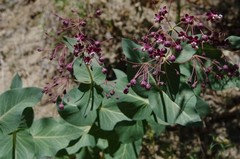
Tina_n_Sam
10 years agoSandy,
I hope you will find this message. I have an A. purpurea and would like to hand pollinate it. I saw the video.
However, how long should I wait after the flowers bloom before trying to hand pollinate?
Once the flowers open, when should I to hand pollinate? Same day, wait a few days, a week?
I tried searching on the internet but didn't find any pertinent info.
Also, if anyone else knows, I would be much obliged.
Thanks,
Tina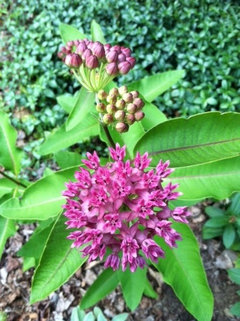
Mark (wildflowerman_2000) Rose
10 years agoTina,
I would recommend that you wait for 2-3 days after the flowers open to try hand pollinating them. A good sign is when you see any insects visiting the flowers try to pollinate them as they should be receptive to pollen. Good Luck! and let us know how you do.
Markbutterflymomok
10 years agoTina, sorry I didn't see your message yesterday. You got good advice from Mark. The insects will indicate when the flowers are ready. Have you watched the video on Youtube that shows how to pollinate the flowers? It is very informative. I used very fine needled tweezers-- the ones with bent ends. I hope it works for you and you get a lot of seed pods.
I just came in from finding my biggest Purple MW partially pulled into the ground by my resident gopher. Thankfully, I was in time to rescue one stem of the plant that still had some roots attached. It's now in a pot, and I removed most of the leaves to feed the Monarch cats I'm raising. I have a dozen small plants that I started from seed. If you get good seed, this is an easy milkweed to grow from seed. My seed came from Prairie Moon.
Sandy
kchd
10 years agoHi there, milkweed aficionados!
I must say I really enjoyed reading this thread, and learning something new about how milkweeds are pollinated. I went out and tried it on my A. incarnata, and was easily able to lift several pollinium; but, like Mary said, not sure if I got it cross-pollinated into the right spot... I guess I'm not completely sure exactly where it goes. Right back in the same place it came from, but on a different flower?I have lucked up with 2 A. variegata plants showing up and blooming this year on our 4 acres. They were approx. 25 yards apart from each other, and being visited some (but not extensively) by pollinators. I did not get any seed pods; bummer! Wish I had known about the unusual pollination strategy of milkweeds while they were blooming, because I surely would have tried it myself.
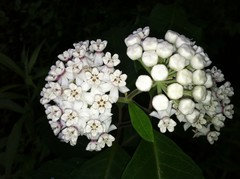
I do have seeds from my A. viridis to share, if anyone is interested.
{{gwi:78110}}
Go, bumble, GO!This post was edited by kchd on Fri, Jun 28, 13 at 17:40
Mark (wildflowerman_2000) Rose
10 years agokchd,
i would love some of your A. viridis seed. I've been trying to locate some viable seed for several years now with no luck.
Mark (wildflowerman_2000)kchd
10 years agoSure thing, Mark! I sent you an email.
Any other takers?
Terrene, I already have a pack with your name on it ;)Katie
Tina_n_Sam
10 years agoKatie, your MWs look very healthy.
The A. viridis looks better than the ones on the internet.
I would like seeds. My concern is that it is not distributed in CT as listed on wildflowers.org.
Not sure if I should be introducing it to here.
-Tina
kchd
10 years agoTina, you are right; A. viridis is not listed as present in the Northeast US. It is reported to be hardy to zone 4. So, it is up to you depending on how much of a strictly native garden you'd like to grow. :) I'm not a complete purist, but I strive to that end.
Katie
butterflymomok
10 years agoIt's possible A variegata will bloom again later in the season. I've had that happen when seed pods didn't form. So be on the look-out. Viridis is doing well this season here in Oklahoma. I have been collecting pods, and will also have some seeds to share if you run out. I found a plant with beautiful deep purple tinged leaves that I'm waiting for the pods to mature. Thinking that planting these seeds ASAP might make sense, as they are essentially planted when the pods open and the seeds fly out to ride on the breezes. Has anyone planted the asclepias seeds as soon as they matured? What kind of luck have you had? Did you direct plant or plant in pots?
Sandy
This post was edited by butterflymomok on Sat, Jun 29, 13 at 20:40
Mark (wildflowerman_2000) Rose
10 years agoSome of the Asclepias seed do not need any stratification and will germinate rather quickly. If I get fresh seed from any species early in the season (before 9/1) I immediately sow them. Sometimes they will start germinating within two weeks or wait until next spring. I would love to get some seed from the red-edged leaf one if you have extras.Also would like to get some of the regular viridis to have it from two different sources.
Markkchd
10 years agoMark - I dropped an envelope of A. viridis seeds for you into the mail on Saturday. I collected them this month (June 2013).
Sandy - I did not know that A. variegata would re-bloom sometimes later in the season. Here's hoping that mine will do so!
Katie
Mark (wildflowerman_2000) Rose
10 years agoHi Folks,
I've written Gardenweb requesting that they add a special MILKWEED forum for those of us who are trying to establish milkweed gardens/plots to help with the declining Monarch populations. If you are so inclined please drop them a note supporting this idea and maybe we will have our own forum in which to communicate.
Regards,
Mark (wildflowerman_2000)butterflymomok
10 years agoMark,
I put in a request for a milkweed forum. Hope it happens. Thanks for your reply. I'll be spreading some of the viridis seeds as soon as they are collected, and save some for stratifying and potting next spring. When I get the seed from the deeper-colored viridis, I'll send you an email and get your address. There is lots of viridis in the fields around the acreage, so I'll be collecting lots of seeds. Generally the land is mowed before the pods are mature, but some escaped. Earlier this past week, they were still green, but getting close.
Sandy
ctnchpr
10 years agoI have A. variegata pods. In a quick check of my plants, I counted about 75. Maybe some will reach maturity and I can send out some seeds this Fall. These are on 2 stalks from 1 root...
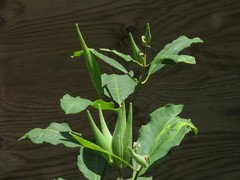
Mark (wildflowerman_2000) Rose
10 years agoGreat News ctnchpr,
Just getting the pods set is a BIG milestone. I have found that if you cover them in fine netting it should help to keep the borers away.Please put me down for some seed when it is available. I'll be glad to help you with distribution if you need it. Please keep us updated on their progress and it's nice to see you still tuned in to this forum. I hope you noticed in this thread that we are working on getting our own Milkweed Forum established and if you wouldn't mind letting them know you are interested in one I would appreciate it.
Regards,
Mark (wildflowerman_2000)This post was edited by wildflowerman_2000 on Fri, Jul 12, 13 at 20:54
Mary Leek
Original Author10 years agoSo nice to hear from you, ctnchpr. I hope you are enjoying a wonderful summer.
Good gracious, miss mollie, what a fantastic sight. Just look at those pods! And the pods and the A variegata plants look so healthy. Keeping my fingers crossed they all mature (can't even begin to guess at the number of seeds contained in that many pods).
Please add my name to the seed list and let me know if I can help in any way. I remember in 2011, someone cleaned and packaged the seed you were so kind to share with us. So, please ask for help if wanted or needed.
Mary
butterflymomok
10 years agoOh, wow, what a treasure! I would like to be put on the list for some seeds. Thanks for sharing your bounty, ctnchpr.
Sandy
kchd
10 years agoHi there, ctnchpr. Those are some nice looking pods you've got there; and 75 of them? Wow, that's impressive! If you get a big batch of seeds, I'd love some, as well.
By the way, my little Lobelia cardinalis seedlings are coming right along.
Mark (wildflowerman_2000) Rose
10 years agoHi ctnchpr,
It's been a couple of weeks since you posted the good news about having so many pods developing on your Asclepias variegata. I'm curious as to how many are still there and growing and at what stage. I hope that they are ALL still there!! A progress report would be much appreciated by everyone who watches this thread.
As I stated before if you need any help with distributing the seed let me know.
Regards,
Mark (wildflowerman_2000)This post was edited by wildflowerman_2000 on Sun, Jul 28, 13 at 10:32
ctnchpr
10 years agoHi wildflowerman,
The Milkweed bugs are taking their toll, the count is down to 20. I shake the plants to dislodge the bugs, about half drop to the ground, where they're crushed, the rest fly off. I just brush the nymphs off, thinking that most won't find their way back to the stalk. It's an ongoing battle!
Most of the pods have about 100 seeds, the very large ones can have 200. If 4 or 5 make it to maturity, I'll be very happy.
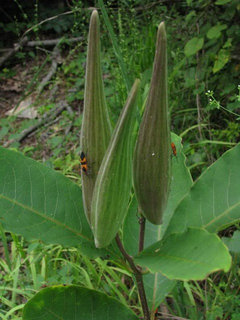
echinaceamaniac
10 years agoI'm so impressed with everyone's plants! If anyone has any seeds of Asclepias variegata to sell me, please let me know. Thanks.
Mark (wildflowerman_2000) Rose
10 years agoHi echinaceamaniac,
Attached is a photo of my 7 pods I have so far this year. Hopefully they will be full of seed but one never knows until they open. Low fertility or weevils can greatly reduce the number of seeds but the pods are clean so far of the bugs.
Hopefully ctnchpr's pods will also have some seed. I don't know how he will distribute them but feel sure if there are some he will share them here on this link.
Mark (wildflowerman_2000)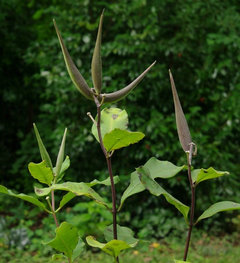
Mark (wildflowerman_2000) Rose
10 years agoHi ctnchpr,
I received your email but can't respond to you directly as it came from gardenweb and not from you.. Please send me your email address at wildflowerman_2000@yahoo.com so that we can communicate about distribution of your seed. Thanks,
Mark (wildflowerman_2000)This post was edited by wildflowerman_2000 on Tue, Sep 17, 13 at 9:02
Mary Leek
Original Author10 years agoJust wanted to add additional information regarding my Asclepias variegata milkweed.
Toward the end of August, my Asclepias variegata milkweed had declined to the point of just dry stalks. Then new shoots began to grow from the base and now one is even setting a flower bud. I don't know if there's time for it to develop and open but the new leaves all look fresh and healthy, just as they do in early spring. I'm wondering if I'd tried cutting the dying stalks back earlier, if I'd have gotten a second round of growth with more blooms?
No seed pods again this year, although I had two tiny seed pods begin to develop from the open flowers I tried to hand pollinate. The little pods grew to about 1.5 to 2 inches, then slowly withered and died. Maybe next year.
Mary
butterflymomok
10 years agoMary,
I wondered about your seed pods. It's also interesting to hear about your new growth. I currently have one plant that is still green. Second plant died back. Both plants are in hardware cloth cages. A purple milkweed is also growing in one of the cages--not sure where it came from. And, am also not sure whether it is competing with the variegata for space. The purple mw is growing in the cage where the vareigata died back. The good news is that I still have at least one plant alive, that the gopher has not been able to attack, although he has tunneled completely around all the cages.
Sandy
dbarron
10 years agoI sure enjoyed seeing this little asclepias in the woods this spring. I'd love to grow it too!
Mark (wildflowerman_2000) Rose
10 years agoHi Folks,
I received the Asclepias variegata seeds from ctnchpr's and am in the process of cleaning and packaging them. I will post the availability next week on the new MILKWEED FORUM. I will only take request for them from that offer so please don't flood me with request until the notification next week. Thanks.
Mark (wildflowerman_2000)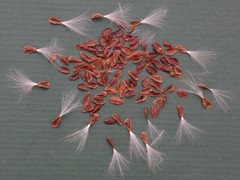
Mary Leek
Original Author10 years agoHi Mark,
Looks like some nice, healthy seed. My thanks to ctnchpr for being so generous with these very special seeds and to you, Mark, for handling the distribution.
I have plans to go to Ft. Benning, Georgia Thursday for grandson's graduation from boot camp. I'll watch for your notice and hope it is posted before I have to leave.
Good luck to all.
Mary
Mark (wildflowerman_2000) Rose
10 years agoHello Milkweed folks,
I will be posting the availability of the Asclepias variegata seed from ctnchpr later today on the new MILKWEED FORUM. I wanted to give folks on this thread a little advance notice before I post on the other forum. I have 24 packets of 25+ seeds each to distribute. These seed will be offered on a first-come-first-served basis. The viability looks like it will be low-hence the large number of seed in each packet. Please respond to my private email and NOT on this thread. Those that do use this thread will slip to the bottom of the list. My email address is : wildflowerman_2000@yahoo.com . Please put "Redring Milkweed" in the subject line. Those emails arriving with no subject line will be automatically deleted for security reasons. Happy Sowing!!
Regards,
Mark (wildflowerman_2000)milkweedmanic
9 years agoI received about 50 seeds of ctnchpr's 2013 stock through wildflowerman in January, in two packets. All seeds in one packet were very small, shriveled and brittle; most in the other looked somewhat more plump. I used cold, damp stratification in a sand medium in the fridge and planted them in a compost, soil, sand mix in early May. Only one seedling appeared, and it produced a plant that is still only about 3 inches tall, and is somewhat chlorotic. Nevertheless, it has survived, and when I planted it out into the yard, I found it had surprisingly well-developed roots. I will cover it with a few inches of light mulch before winter and hope it pulls through.



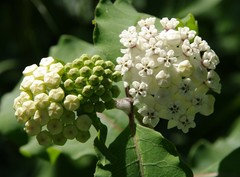
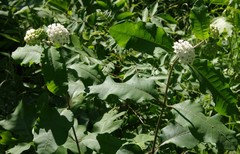
ctnchpr